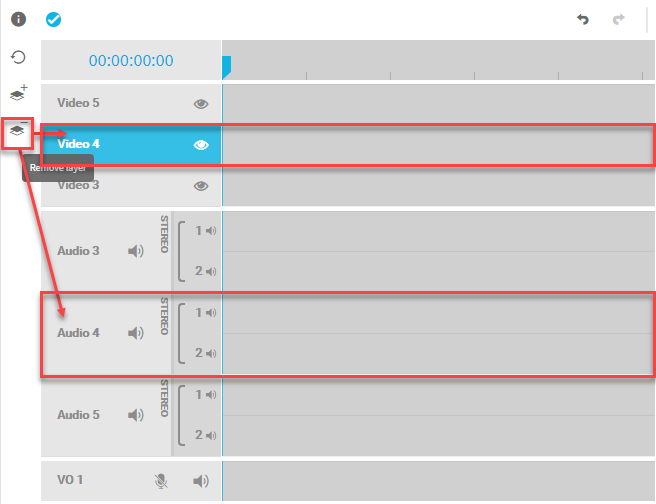Toolbar Options [ VE 20.2 UG]
When working on the timeline area, users will notice the timeline toolbar. It contains a series of options and functions to facilitate the editing process when assembling a sequence.

Add / Delete Tracks
By default, VidiEditor projects are created with 2 video and 2 audio tracks. The “Add Track” button allows one to add up to 5 video and audio tracks. Audio and video tracks will be added and deleted together when adding new tracks so you will have the same amount of audio and video tracks. The Voice Over track cannot be controlled using those options. It is always available.
When deleting a track, users to select a video track. Clicking on the delete option will delete the selected video track as well as the related audio track. For example, the following figure illustrates deletion of video and audio tracks with number 4.

Also a track can just be deleted if it is empty.
Reset Timeline
This option can be used to delete all work done on the timeline to reset it to the initial state. In result the user gets an empty timeline.
Keyboard Shortcut Info
Opens an info dialogue listing all the keyboard shortcuts available in VidiEditor. See also Keyboard Shortcuts [ VE 20.2 UG]. Furthermore all toolbar options having a keyboard short display this in the tooltip when hovering the button.

Undo/Redo
Undo and Redo: Selecting the "Undo" button will go back to one previous action. If after performing an "Undo" the user changes their mind, they can return to one action before the "Undo" by selecting the "Redo" button.

Please note that number of actions is limited and just considered until the browser is refreshed and to a maximum of 100 interactions.
Cut Segment
Cut Segment: Performs a segment cut wherever the playhead is positioned in the timeline. The cut affects all segments of the selected track. Segments on not selected tracks will not be cut.

Please note: If all segments of all tracks should be cut the keyboard shortcut ctrl + k can be used.
Link/Unlink
This options allows to unlink the video and audio segment of media from type video enabling the use to make compositions with overlapping audio / video areas. It can be only used for one selected segment to unlink and relink back the originally related audio and video elements.

Delete Segment
Delete Selected: This removes the selected segments in the timeline. Please refer to the Delete and Ripple Delete section for more details.

Zoom
Zoom: By dragging the scale horizontally, users are able to zoom in or out of the timeline. As a result, the visually represented space between time intervals is either increased or decreased with the zoom.

It is important for users to note that users are able to scroll along the timeline (1).
Previous/Next Segment
Previous and Next Segment: Selecting either option will skip to the beginning of the previous or next segment in the timeline.

Snap
Snap: Selecting this option will activate the magnetic snap behavior when bringing timeline segments in close proximity to each other. This is used to automatically and accurately remove the gap between two segments frame accurate.

Move / Overwrite Mode
This toggle switches between the 2 modes: move and overwrite. This is related to segments added to and moved into/in the timeline. When using the move mode, one segment would not overlap or shorten another segment on the same track. In result it moves existing segments when moving a new segment on the same position. The overwrite mode will overwrite an existing segment when moving a new segment on the same position. Please check out Move / Overwrite Mode [ VE 20.2 UG] for a detailed explanation and Insert Edit Using Keyboard Shortcuts [ VE 20.2 UG] for a practical example on move / overwrite editing from the source preview player.

Ripple Edit
This toggle switches the ripple edit mode on and off. If it is turned onm it will affect the behavior of timeline segments that are in the timeline future seen from a changed segment. For example, shortening a segment in the middle of the timeline while trimming the out point will shift all following segments accordingly when the ripple edit mode is on. Please read Ripple Edit and Ripple Delete [ VE 20.2 UG] for a detailed explanation.
Publish Timeline
To finalize a project and distribute it to a new video file, the transcoding of new media file can be started using the publish option. This will open a dialogue offering different options depending on the VidiEditor version and configuration used. Possibilities are to trigger a Vidispine conform job, a VidiFlow workflow, set a target format or storage, and to fill out metadata for the new item. A more detailed description of the options is provided in Publishing Sequences [ VE 20.2 PO] .
.png)